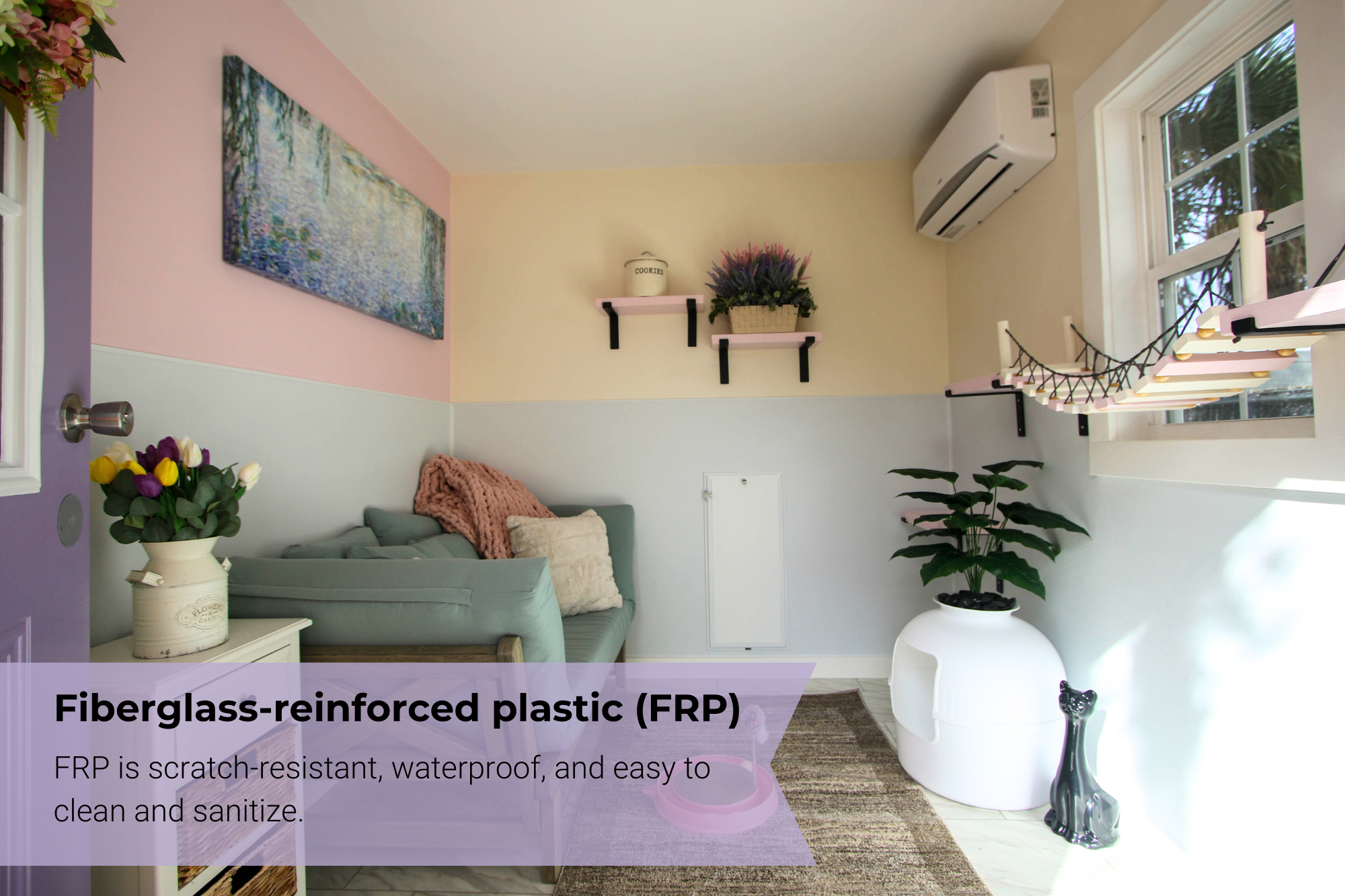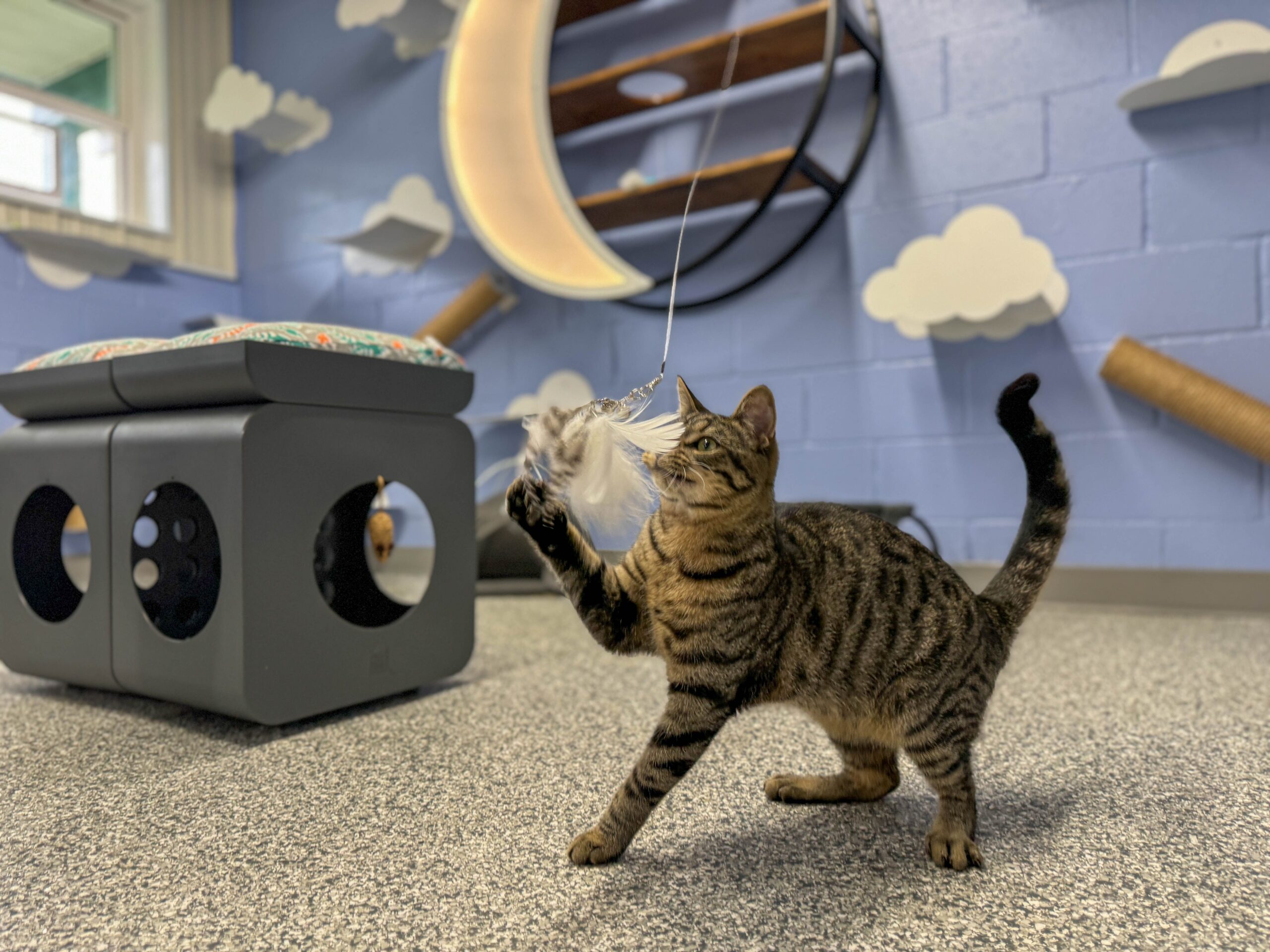Making your shelter space pet-friendly doesn’t have to break the bank or require a complete overhaul! With a few simple adjustments, you can create a safer environment for pets while also protecting your property from excessive wear and tear. Whether you’re looking to enhance your living space for your furry friends or reduce potential damage, here are some easy ways to tailor your space to accommodate pets!
Flooring
When selecting a flooring material for your pet-friendly space, durability and ease of cleaning are likely to be the most important factors you’ll want to keep top-of-mind. Accidents will happen and fur is inevitable! Ensuring that your floors can stand up to whatever is thrown at them will make your space easier to manage and more pleasant for future guests.
Luxury Vinyl Tile & Plank
Our favorite flooring for pet-friendly spaces is luxury vinyl tile (LVT) or luxury vinyl plank (LVP). These products are easy to clean, easy to install, and are relatively inexpensive at $4 to $13 per square foot.
We recommend paying a bit more to get one that is labeled as “waterproof” rather than “water-resistant” to ensure that any potty accidents or water spills will be stopped in their tracks! An attached underlayment pad will help reduce noise and a quality wear layer will ensure that your floors are resistant to scratches and scuffs. LVT and LVP floors are a great option for residential areas as they offer both durability and affordability without compromising on aesthetics.
Epoxy
Epoxy is a wonderfully pet-friendly flooring option that is resistant to wear and scratches and offers a smooth surface with minimal cracks, making it incredibly easy to clean and sanitize. Epoxy floors are commonly seen in commercial settings like hospitals, retail stores, and airports but rarely used in residential spaces outside of garages. At $5-$15 per square foot, epoxy is a slightly more expensive option than LVP, so it’s important to shop around for multiple quotes before hiring a contractor to install this flooring. If installed correctly however, epoxy can last for 10-20 years, making it a worthwhile investment for shelters with long term goals.


Tile
Tile is a beautiful flooring option that is both waterproof and durable when installed correctly. However, installing tile is more complicated than other types of flooring and should only be attempted by a professional or someone with tiling experience. If any of the tiles are not installed properly, they are very fragile, requiring expensive repairs. When it comes to cost, tile flooring tops our list at approximately $9-$53 per square foot, making it a difficult option for shelters on a budget.
Commercial Vinyl Sheet Flooring
Commercial vinyl sheet flooring consists of a single, continuous sheet of polymer material, typically manufactured in widths of 6 to 16 feet. Unlike LVT or LVP, commercial vinyl sheet flooring comes in large rolls. Once installed, this flooring will have very few seams, making it even more resistant to water seepage. Conversely, the lack of seams can make routine maintenance more difficult. If a section of vinyl sheet flooring gets damaged, you’ll need to cut and replace the entire section rather than just swapping out a single tile.
In terms of cost, commercial vinyl sheet flooring generally ranges from $8 to $25 per square foot. However, it will need to be installed by a professional, adding additional labor costs.
Unlike commercial grade, residential grade vinyl sheet flooring tends to be low quality and not durable enough for high-use pet spaces.


Carpet
As you may have guessed, carpeting is not an ideal flooring option for pet-friendly spaces as it is difficult to clean, impossible to sterilize, and traps pet hair and other allergens. Removing old carpet is a great volunteer project for shelters on a budget and washable rugs like those found on Ruggable can be a great alternative to add more warmth to a space!
Walls
While certainly not required, some shelters opt to include updates to their building’s walls when pet-proofing their space. Most walls in residential buildings are made of drywall, which is not designed to get wet and is relatively soft and easy to damage.

A popular option for shelters on a budget is to cover their walls in fiberglass-reinforced plastic (FRP). FRP can be used to cover the entire wall or, more commonly, just as a wainscoting. It is easy to clean and durable enough that you won’t have to worry about damaging it with abrasive cleaners. It comes in a variety of colors, textures, and thicknesses and installation is relatively straightforward. Just remember to caulk all the edges of your FRP trim with a solvent-based caulk so no water can penetrate behind and get to the drywall.
Trim
Wooden trim holds moisture, is vulnerable to chewing, and can be damaged by strong cleaners. Its imperfect surface can also harbor bacteria resulting in bad smells that linger. We recommend swapping out wooden trim for a PVC or vinyl alternative.
PVC and vinyl trims are durable and easy to clean. They hold up well to chewing and scratching by bored pets and will help protect your walls from potty accidents.
When installing or replacing trim, it’s important to use a high-quality, solvent-based caulk to seal the edges. This step is essential to preventing messes from getting to your drywall or under your floors. Caulk will also help fill grooves where pet dander and dust might otherwise linger, ensuring that rooms can be thoroughly cleaned. Unlike water-based caulk, solvent-based caulk holds up well to frequent cleaning and will last significantly longer.
Windows
Just like you, pets are curious about their surroundings and enjoy looking out windows. If you have windows in your pet spaces, consider getting sturdy window coverings that won’t be easily bent or broken if a pet plays with them or pushes them aside. Avoid window shades with long drawstrings as these can pose a safety hazard should a pet become entangled in them. If traditional curtains or shades with a string are already in the space and cannot be replaced, consider adding a wall hook to keep dangling pieces safely out of reach.
Doors
The style of door handle you select could mean the difference between a secure pet and an escape artist on the loose! Whenever possible, we recommend opting for round doorknobs rather than door handles. For savvier pets, door handles provide the opportunity to open the door by simply pulling down on the handle and using their body weight to open the door. Doorknobs are a safer option since pets cannot easily grab or maneuver them.
Where door knobs are not possible, consider child-proof locking devices to keep pets in where you want them and out of where you don’t! Baby gates are also helpful in this area. Don’t forget that some dogs can jump over or climb gates, so only use them in supervised areas or with pets you know will stay behind them. Gates are a good deterrent for cats to prevent them from rushing at doors but don’t forget that most cats can easily jump a baby gate, given the opportunity.
Consider installing door kicker plates to prevent pets from scratching or chewing the bottom of your doors. Kicker plates also make cleaning pet grime off the door much easier! Plates can be purchased in a variety of colors to match your decor.
Furniture
When choosing furniture for your pet-friendly space, look for items that are easy to clean and resistant to damage from chewing and scratching. Outdoor furniture is often waterproof and comes with removable, washable covers, making it a good option for even indoor spaces!

When selecting for durability, metal is a great choice followed by solid wood. Meanwhile, materials like wicker and woven fabrics are likely to attract cat claws and trap fur and allergens.
Keep in mind that the placement of furniture can be just as important as the furniture itself! Do you have wall art, mirrors, lamps, or other breakable items in your rooms? Pets are creative and often climb on furniture to reach places they may not otherwise be able to access. Be thoughtful about furniture placement to keep pets safe and out of trouble. If your room has drop ceilings, ensure that there are no opportunities for cats to climb up and push into the ceiling tiles.
Enrichment
A great way to pet-proof your space is to provide items that keep pets engaged in positive behaviors! Enrichment gives pets an outlet for physical and mental energy and provides them with choice and control over how their spend their time. An enriched pet is a happy pet and a happy pet is a less destructive pet!
For cats, scratching posts and vertical climbing spaces are no-brainers. Climbing and scratching are natural and healthy cat behaviors, so its important to provide them with opportunities to do both. We recommend adding sturdy shelves to walls for cats to climb. They come in all different shapes and sizes to fit your space. Assume a cat will jump to any surface they can reach (cats have an impressive ability to jump 6-8 feet vertically), so be careful when choosing furniture and décor. Ensure furniture is either fastened to the wall or heavy enough not to be tipped over if jumped on. Don’t forget to add some toys and places to hide, too; cats love to play!
When it comes to dogs, food puzzles, reward-based training, and access to the outdoors are great ways to keep pups engaged. When possible, we love to add dog doors to pet-friendly rooms. These doors can be attached small fenced-in yards or kennels so that dogs can go in and out as they please and retain their potty training.





